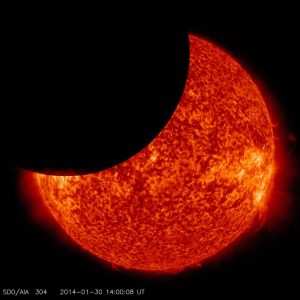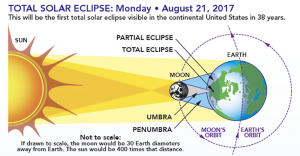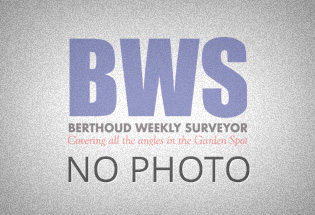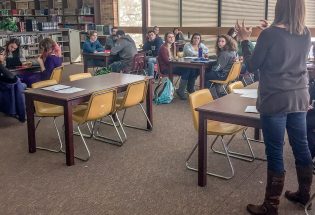Rare total solar eclipse coming August 21
By Amber McIver-Traywick
The Surveyor
On Monday, Aug 21, parts of the U.S. will get to experience an awe-inspiring total solar eclipse. The eclipse will begin its exclusive trail across the U.S. in Lincoln Beach, Ore., at 9:05 a.m. PDT and end near Charleston, S.C,. at 4:09 EDT.

Photo Credit: NASA/SDO On Jan. 30, 2014, the moon moves between NASA’s Solar Dynamics Observatory, or SDO, and the sun, giving the observatory a view of the partial solar eclipse from space.
This will be the first total solar eclipse in the U.S. since 1979, and the last time one stretched across the entire United States Charlie Chaplin and Harry Houdini were the stars back in 1918. This is also the first total eclipse to only be seen exclusively in the U.S. since 1778, although a partial eclipse will be seen elsewhere, making it even more extraordinary.
According to NASA’s Eclipse 101 webpage, a solar eclipse happens when the moon moves between Earth and the sun. Depending on your location for this eclipse you can experience either a total or partial eclipse. A total eclipse occurs when the observer is under what’s called the umbral shadow of the moon. As the sun is completely covered it exposes the sun’s atmosphere, the corona, which we normally are unable to see.
Wheatland, Wyo., will be the nearest town to Berthoud located in the path of totality, the approximately 70-mile-wide (and thousands of miles long) stretch of land in which the sun will appear completely eclipsed. If you make it to Wyoming, the sun will be covered and day will appear to become night for nearly two and half minutes; amazing and possibly a bit disconcerting. If you pay attention during the event you may even spot nocturnal animals that are a bit confused by the sudden darkness, popping their heads out prematurely.
If you do plan to travel, the U.S. Federal Highway Administration recommends planning your trip ahead of time and leaving early, as traffic is expected to be extremely heavy heading into these areas. Many hotels and campgrounds have been booked for months.
However, if you stay in the Berthoud area, you will still get to see around a 90 percent eclipse beginning at 10:23 a.m. that will peak around 11:46 a.m. and end at 1:14 p.m.

Photo Credit: NASA – This illustration depicts the alignment of the sun, the moon and Earth which only perfectly occurs about once every 18 months, on average. The umbra and prenumbra are shown.
The sun’s intense ultraviolet radiation, even during an eclipse, can still cause damage to the eye. To view the eclipse safely and avoid damage to your eyes, or even blindness called solar retinopathy, consider purchasing or making your own eclipse viewer. According to the American Academy of Ophthalmology, “The only time that you can look at the sun without a solar viewer is during a total eclipse. When the moon completely covers the sun’s bright face and it suddenly gets dark, you can remove your solar filter to watch this unique experience.” Once the bright crescent of the sun starts to reemerge, protective eyewear needs to go back on.
Viewers that resemble 3D-glasses can be purchased online and locally at several retailers, but make sure somewhere on the viewer it is marked as meeting the ISO 12312-2 (sometimes written as ISO 12312-2:2015) international standard. These filtered lenses are certified to reduce visible sunlight to safe and comfortable levels and also block solar UV and IR radiation.
Building a pin-hole viewer is also a fun activity to safely view the eclipse, and small telescopes and binoculars can even be used to project an image of the eclipse onto another surface for safe viewing. During the event take note of the shadows cast by trees as the gaps between the leaves act as a pin-hole viewer themselves and the crescent shape of the eclipsed sun will appear in duplicate where the shadows fall.
To commemorate this special event, the US Postal Service has even issued a first-of-its-kind, heat-activated Forever-stamp that, upon touching, transitions from a picture of the eclipsed sun to the moon. Many entrepreneurs are also getting ready for the event by selling eclipse merchandise. Everything from coffee mugs to hats, buttons, bumpers stickers, t-shirts, and even underwear that say things like “I survived the total eclipse of 2017” and “I heart solar eclipses” are available online.
If you happen to miss this eclipse, your next chance to view one will be in an area stretching between northern California and Florida on Oct. 14, 2023, and again between Texas and Maine on April 8, 2024.
NASA will be live-steaming the event for three hours. The broadcast will include unique coverage with discussion on multiple eclipse topics. The NASA website is also a great resource for all things pertaining to the event, including how-to information for building your own pin-hole viewer and eclipse activity guides. Visit https://eclipse2017.nasa.gov for more information.
- February, 01 2021

News Bites – January 28, 2021
A crash on U.S. Highway 287 Tuesday, Jan. 26 resulted in the death of 34-year-old...
- April, 28 2017

Obituary – Peter N. Bridgman
Peter N. Bridgman Jan.24, 1946 – March 6, 2017...
- October, 05 2017

Berthoud Elementary and Ivy Stockwell...
By Aaron Reynolds The Surveyor Berthoud continues to remain one of the more sought-after places...
- March, 10 2016

BHS group benefits homeless
Group hopes to raise $1,000 by end of the month Berthoud...
- February, 08 2018

Nick Foles, a perfect example of what...
By Dan Karpiel The Surveyor Did you watch the Super Bowl on Sunday? I did....
- September, 01 2022

Pesky mosquitos and public health col...
Berthoud’s Board of Trustees held their usual gathering on Tuesday. Their points of discussion included...

POLICEBLOTTER
Community News
Northern Water sets C-BT quota at 70% for 2024
Community News

Emotions run high during Revere Property hearing
Community News
Snowpack at 119% above normal
Community News

Karspeck to serve third term as Berthoud mayor
Community News

OPINION – No bitchin’ allowed
Community News
Roy Tripi to become principal of BHS on July 1
Community News
COMMUNITY CALENDAR:
Community Calendar – add an event
Homestead Fine Art Gallery First Fridays OPEN HOUSE
03 May 4:00 PM - 7:00 PM
Homestead Fine Art Gallery First Fridays OPEN HOUSE
07 Jun 4:00 PM - 7:00 PM
Homestead Fine Art Gallery First Fridays OPEN HOUSE
05 Jul 4:00 PM - 7:00 PM
Homestead Fine Art Gallery First Fridays OPEN HOUSE
02 Aug 4:00 PM - 7:00 PM
Homestead Fine Art Gallery First Fridays OPEN HOUSE
06 Sep 4:00 PM - 7:00 PM
Homestead Fine Art Gallery First Fridays OPEN HOUSE
04 Oct 4:00 PM - 7:00 PM

